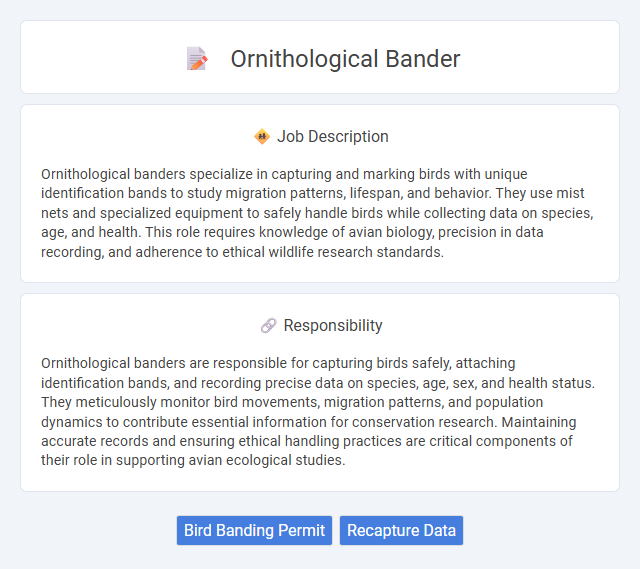
Ornithological banders specialize in capturing and marking birds with unique identification bands to study migration patterns, lifespan, and behavior. They use mist nets and specialized equipment to safely handle birds while collecting data on species, age, and health. This role requires knowledge of avian biology, precision in data recording, and adherence to ethical wildlife research standards.
People with strong attention to detail and a passion for bird conservation are likely suitable for the ornithological bander job. Those who are comfortable working outdoors in various weather conditions and have patience to handle delicate birds may find this role fitting. Individuals prone to allergies or who have difficulty working with wildlife might face challenges in this position.
Qualification
An ornithological bander requires expertise in avian biology, proficiency in handling birds safely, and knowledge of bird banding techniques and equipment. Certification from recognized ornithological organizations, such as the North American Banding Council, often validates skill and adherence to ethical standards. Strong observational skills, attention to detail, and physical stamina are essential for accurately recording data and working in diverse field conditions.
Responsibility
Ornithological banders are responsible for capturing birds safely, attaching identification bands, and recording precise data on species, age, sex, and health status. They meticulously monitor bird movements, migration patterns, and population dynamics to contribute essential information for conservation research. Maintaining accurate records and ensuring ethical handling practices are critical components of their role in supporting avian ecological studies.
Benefit
Ornithological banders may experience enhanced understanding of bird migration patterns and population dynamics, contributing valuable data to conservation efforts. This role likely offers unique opportunities for outdoor work and close interaction with diverse bird species, fostering a deeper connection with nature. The skillset gained, including species identification and data recording, could increase prospects for careers in wildlife research and environmental science.
Challenge
Ornithological banders likely face challenges related to accurately capturing and handling birds without causing stress or injury, requiring precise skills and patience. They may encounter difficulties in identifying species, aging, and sexing birds in the field, which can impact data quality and research outcomes. Weather conditions and remote field locations could also pose significant obstacles to their work efficiency and safety.
Career Advancement
Ornithological banders develop expertise in bird identification, aging, and measuring techniques, positioning themselves for advanced roles in wildlife research and conservation management. Mastery in data collection and analysis enhances opportunities to contribute to scientific publications or lead field projects. Networking with research institutions and obtaining certifications in wildlife handling further accelerate career growth in the ornithology sector.
Key Terms
Bird Banding Permit
A Bird Banding Permit is essential for ornithological banders to legally capture, mark, and study birds for scientific research and conservation purposes. This permit, issued by wildlife agencies such as the U.S. Geological Survey's Bird Banding Laboratory, ensures adherence to ethical standards and protocols in bird handling and data collection. Skilled ornithological banders utilize this authorization to monitor bird populations, migration patterns, and species health, contributing to vital avian ecological knowledge.
Recapture Data
Ornithological banders specialize in capturing birds to attach uniquely coded bands for identification, then rely heavily on recapture data to track bird movement, survival, and behavior patterns over time. Recapture data provides critical insights into migration routes, population dynamics, and lifespan, essential for conservation and ecological studies. Accurate recording and analysis of these data points enhance understanding of species ecology and inform targeted wildlife management practices.
 kuljobs.com
kuljobs.com